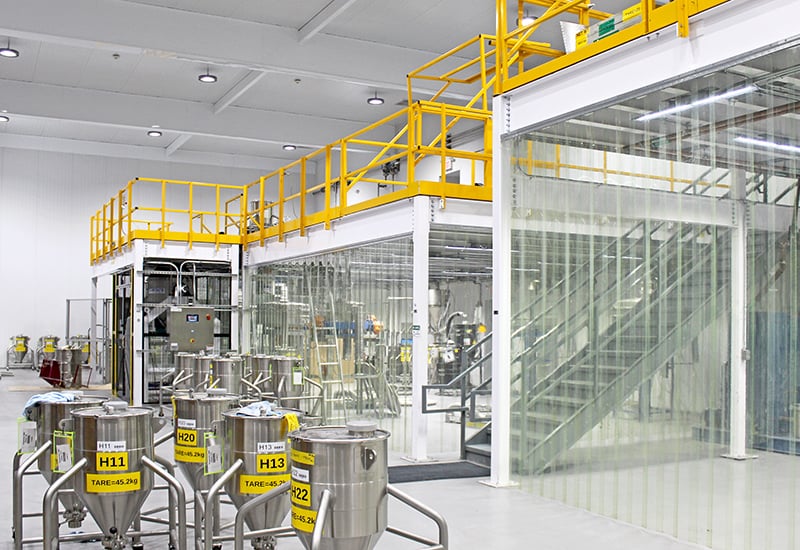Read time: 5 mins
Date posted: Jun 2019
Theme: Additive Manufacturing, Material Innovations
The powder perspective: How advanced digital materials push the industrialization of Additive Manufacturing (Part 02)
The Industrialization of Additive Manufacturing continues to rock the manufacturing industry, but it is the relationship between materials and processes that enable innovation at industrial scale. In part two of our interview series on GKN Additive Materials and digital materials in AM, we spoke with Chris Schade, Director Additive Materials, of GKN Powder Metallurgy to discuss the powder perspective.
In part one the series Guido Degen, President of Additive Manufacturing at GKN Powder Metallurgy, shared why material is the true driving force that pushes the boundaries in additive manufacturing. Now you’ll get to know the origin of the power – it’s the unique customer understanding coming from dedicated customer support and an eagerness for engineering excellence.
GKN Additive and GKN Hoeganaes have recently announced to merge their material expertise into "GKN Additive Materials" - a new sub brand of GKN Additive, fully dedicated to advanced AM powders. Where does GKN Additive Materials benefit MOST from GKN Hoeganaes’ long-standing history as a world leader in PM production?
Schade: The biggest advantages we offer are our history of alloy development, our history of knowing what the industry needs as a whole and our history of working with customers closely to develop materials for specific applications. The close connection between AM and the PM market allows us to use a lot of our historical information and experience to create new products and new markets. Even though the thermal processing and materials processing are different, the fundamentals are still the same.
Addressing core customer needs with digital powder
What are the greatest challenges our customers face when it comes to AM materials? How are we addressing these challenges?
Schade: I think the biggest challenge our customers face is material selection. For example, when people look at a part, they look at the typical composition that may be on a print or specified by their customers. They quickly assume that this is the material that is necessary to successfully make that part.
.jpg?width=800&name=How-advanced-digital-materials-push-the-industrialization-of-Additive-Manufacturing-(03).jpg) We offer metal powders for AM applications from prototyping to series production including water- and gas-atomized steel powders, gas-atomized aluminum, copper, nickel and titanium powders. (© GKN Powder Metallurgy)
We offer metal powders for AM applications from prototyping to series production including water- and gas-atomized steel powders, gas-atomized aluminum, copper, nickel and titanium powders. (© GKN Powder Metallurgy)
However, the material chemistry is only one aspect of the product. The processing of the material can change not only the physical properties, but the microstructure of the material as well. I think our customers face a huge challenge in convincing their customers that the print may not always list the best material choice.
Our new techniques with AM may require a change in the chemistry. In many cases, the product will benefit from this because we can take full advantage of the AM process capabilities to make a better product.
.jpg?width=800&name=How-advanced-digital-materials-push-the-industrialization-of-Additive-Manufacturing-(05).jpg) We provide high purity, gas- and water- atomized powder for scalable additive manufacturing applications. (© GKN Powder Metallurgy)
We provide high purity, gas- and water- atomized powder for scalable additive manufacturing applications. (© GKN Powder Metallurgy)
How does our implementation of a digital powder platform benefit our customers?
Schade: For the digital implementation of powder, one of our responsibilities is to provide the customer with as much technical information on the powder properties as possible. Many of the end manufacturing platforms have different acceptability levels for things like powder flow, particle shape, chemistry, oxygen content and moisture content.
When a customer requests powder from us, we have completed all testing for them. We have a list of standard tests that certify our material to a specification, but if a customer comes to us with a test that they’d like to see, we can normally obtain results for them. All of this is captured in our digital system and can be recorded and viewed historically by our customers on a real time basis. This provides our customers the support they deserve.
.jpg?width=800&name=How-advanced-digital-materials-push-the-industrialization-of-Additive-Manufacturing-(01).jpg)
In our world class R&D and manufacturing center in Cinnaminson (NJ), we have access to all relevant capabilities in production technology, including a powder research laboratory with various competencies from metallography to powder morphology and much more. (© GKN Powder Metallurgy)
Predictive material development adapted to the needs of tomorrow's applications
Material technology is a critical success factor for the future mass adoption of Metal 3D Printing. Where do we focus our R&D activities to bridge the gaps?
Schade: Much like the materials for a powder producer in powder metallurgy and metal injection molding, having a wide range of materials is important. Realistically, you can only create so many materials.
We focus our R&D efforts on creating materials that span a wide range of properties with a limited number of chemical compositions. Our customers can then tailor their processes for a few materials to cover a range of material properties.
.jpg?width=1024&name=How-advanced-digital-materials-push-the-industrialization-of-Additive-Manufacturing-(04).jpg)
Not only does this help the powder producer, but this also helps the standards committees: They can focus their efforts on a certain set of materials to create standards for. This inadvertently helps to market these materials to our end-user customers across multiple industries. If the industry is strong with standards, then we have done our job effectively.
From your experience, what trends will influence future AM material development activities?
Schade: Regarding AM material development activities, it goes back to the conversation that from a thermal history and mechanical particle standpoint, the AM process is very different from MIM and conventional PM. Material development is based on what the customer needs as the final property.
For example, a 316L stainless steel produced for conventional PM may have a different microstructure than when produced by AM. Being able to navigate and understand the reasons why property changes occur and how we can influence them to meet the final part properties will be the number one R&D activity.
We produce a material for an application; we do not produce a material to the standard of the powder. We create and change the chemistry and shape of the powder to meet the end goal of the customer, and that most likely is the mechanical properties of the part.
Helping customers to stay ahead with the human factor and selected strategic partners
Advancing the field of metal AM is an important task; who are the strategic partners of GKN Additive Materials to develop this young industry? What does each collaboration bring to the table?
Schade: Our partners in the AM industry are not only customers we work with closely, but also the standardization committees like ASTM and particularly MPIF. These groups help develop standards for materials and processing: in this young industry, there is much speculation around what needs to be completed to provide a uniform and consistent product.
We also work closely with universities and research groups to better establish new test methods and determine necessary measurements on both powder and parts. We have a plethora of collaborators, not limited to just our customers. We work with different industries and machine manufacturers to grow the material collectively. GKN Hoeganaes has continued this process for years in the PM world, and now we are navigating this AM world with the same mindset.
We always have an open door and offer customers continuous access to our R&D and manufacturing center. Touring our facility, while talking to our high-level specialist and getting an overview of our capabilities and services gives them a 360-degree overview. That’s an excellent starting point to explore how to grow their opportunities with us.
.jpeg?width=799&name=How-advanced-digital-materials-push-the-industrialization-of-Additive-Manufacturing-(02).jpeg) Doors are always open for customers in our R&D and manufacturing center in Cinnaminson (NJ). We believe in continuous open dialogue to create solutions that enable our customers to stay ahead. (© GKN Powder Metallurgy)
Doors are always open for customers in our R&D and manufacturing center in Cinnaminson (NJ). We believe in continuous open dialogue to create solutions that enable our customers to stay ahead. (© GKN Powder Metallurgy)
Often times, customers appreciate the “human factor” – someone to speak with when a question or problem arises. How does this dedicated team of material professionals support customers with metal AM production?
Schade: GKN Hoeganaes has a long history of connecting one-on-one with our customers, with customer service agents that help with sales, delivery, contract negotiations and any other details that need supporting. We also pride ourselves on our technical professionals who are with the customer every step of the way in the design of the product.
From the beginning, we go to the customer to help understand the concept of what they are looking for and follow up until the end, reaching every milestone in between. We support with material properties, design and other technical issues that may arise with the powder, like health and safety.
The human factor notion is something we strongly believe in at GKN Hoeganaes, continuing years of support and will continue to do so with the new AM market.
Thank you.




